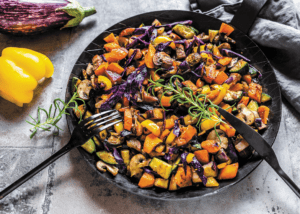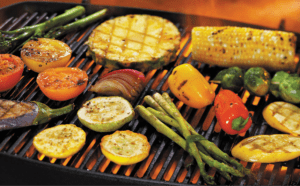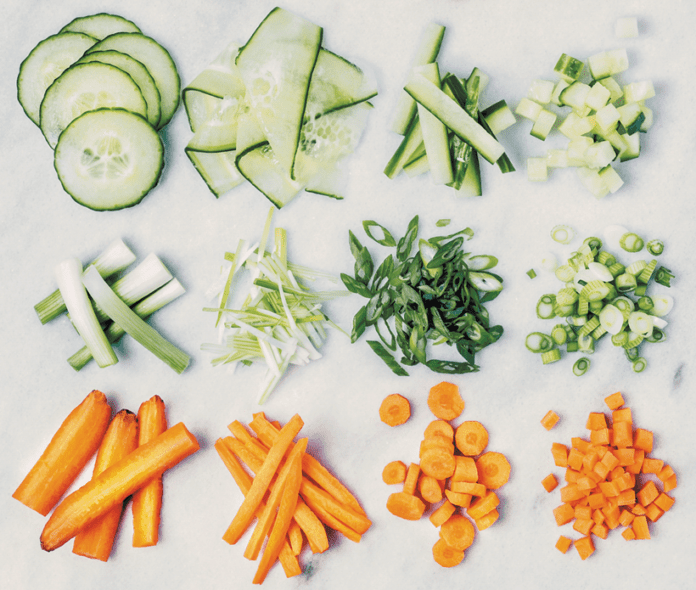The research is clear: eating more whole or minimally processed plants is better for our health. Knowing how to easily make foods like vegetables taste great can help you consume more of these health-promoting options in place of less healthful choices.
Building Flavor. Most U.S. adults don’t meet the recommended intake of vegetables. When we do eat veggies, we often limit ourselves to those we are familiar with and already taste good to us. However, if your goal is to eat more of these health-promoting foods, a little creativity can help expand your palate,
discover new preparations of your favorite veggies, and find new veggies to enjoy. One approach to accomplish this is to boost flavor.
We enjoy foods more when they are flavorful. “Flavor is typically
 defined by the ‘five tastes:’ sweet, bitter, salty, sour, and umami,” says Suzannah Gerber, a PhD student at the Tufts Friedman School, as well as a chef, and cookbook author. “In culinary practice, chefs create combinations of these flavors to achieve complexity or depth. Common techniques like slow roasting, deep marinating, herbing a crust, or topping a custard with tart fruit combine multiple tastes to keep the mouth interested in each bite. Examples of this layering would be the sweet/savory combination of the controversial pineapple on pizza, or the salt in caramel ice cream. It can also be discovered in the bittersweet notes of chocolate in an earthy spiced mole sauce, or the bitter-acidic coffee in a steak rub.”
defined by the ‘five tastes:’ sweet, bitter, salty, sour, and umami,” says Suzannah Gerber, a PhD student at the Tufts Friedman School, as well as a chef, and cookbook author. “In culinary practice, chefs create combinations of these flavors to achieve complexity or depth. Common techniques like slow roasting, deep marinating, herbing a crust, or topping a custard with tart fruit combine multiple tastes to keep the mouth interested in each bite. Examples of this layering would be the sweet/savory combination of the controversial pineapple on pizza, or the salt in caramel ice cream. It can also be discovered in the bittersweet notes of chocolate in an earthy spiced mole sauce, or the bitter-acidic coffee in a steak rub.”
There are several ways to build flavor. “The key is to work with ingredients to draw out their best features,” Gerber explains. She recommends the following simple techniques:
- Choose Your Size: How you cut your veggies influences their flavor and texture. “If you’ve ever oven-baked a whole sweet potato, you may have noticed that the center stays firm even while the edges start to get dark,” says Gerber. “Baked sliced sweet potatoes, on the other hand, get tender in the middle and crispy on the outside because there is more surface area exposed to the heat. Smaller sweet potato fries get crispier, whereas larger ones are more tender and require more time in the oven—which means more time for the sugars to develop, creating almost caramel-like flavors.”
When going for deeper, savory flavors, try a bias cut, a flat, diagonal cut that exposes more surface area—for roasting or sautéing. This cut amplifies the Maillard reaction, the delicious browning that results when the naturally occurring proteins and sugars in food interact with heat from roasting and grilling. “This delicious reaction amplifies taste, aroma, and visual appeal,” says Gerber.
surface area—for roasting or sautéing. This cut amplifies the Maillard reaction, the delicious browning that results when the naturally occurring proteins and sugars in food interact with heat from roasting and grilling. “This delicious reaction amplifies taste, aroma, and visual appeal,” says Gerber.
- Marinate: This well-known technique is under-utilized with vegetables, according to Gerber. “Marinating helps harmonize seasonings with the natural flavors of the ingredients,” she says. Marinades use a variety of ingredients to infuse flavor, but chief among them is usually acid. “Acids, like vinegar and lemon, are the flavor-builder’s secret weapon because, much like salt and sugar, acid can cut through bitterness in flavor and toughness in texture. Acid also helps the tongue differentiate between layers of flavor, making complex things enjoyable, what chefs call ‘lift.’ Without lift, flavors can fall flat, and it is then that we reach for the saltshaker or the sugar bowl.”
Rubs are another way to add flavor. They can even be used to impart a meat-like flavor to vegetables or tofu, if that makes them more palatable to you or your dining companions. See recipes for some ideas.
- Utilize Temperature: How you use heat has a major impact on flavor. “Roasting or grilling carrots or other vegetables, which involves high heat, draws the naturally occurring sugars to the surface,” says Gerber, “which makes them more flavorful and aromatic.” On the other hand, cooking some foods slowly over low heat—as with a slow simmered stew or a baked veggie lasagna—allows the juices to comingle and soak up herbs and seasonings. This extra time, often called “opening up,” explains why some foods, like your favorite three-bean chili or your grandmother’s stew, taste better the next day.
- Get Saucy: The fourth way to amp up the flavor in your plants is to add sauces. “If you’ve tried your entire life to like Brussels sprouts, a flavorful sauce (combined with quartering and roasting them so they are nice and crispy) might be enough to help you finally enjoy them,” says Gerber. “Toss them in a balsamic glaze or drizzle on your favorite oil-based salad dressing.” You can toss a wide variety of veggies into sauced dishes like curries, stir-fries, and pastas. “Masking a less-than-favorite veggie in a sauce you already love on a dish you already eat is a great way to get bonus veggies,” Gerber says.
You can pack spinach and other nutrient-dense veggies into sauces you may already enjoy, like pesto or red sauce. Additions of puréed vegetables can intensify the color, add nutrients, and sneak beneath the radar of even the pickiest eaters. Sauces are also an opportunity to add more healthy plant-based oils.
- Finish It: Finishing touches can provide a big flavor boost. “We often add finishing touches to salads and pastas, like some grated parmesan. You can also sprinkle sesame seeds or fresh herbs, drip on garlic-infused vinegar, or spritz some lemon on your cooked veggies,” Gerber suggests. “Try sprinkling chopped fresh chives on your favorite minestrone or drizzling on a finishing oil such as a nice bright green basil-infused olive oil or a chili-infused toasted sesame oil.”
Making It Easy. When these techniques become a part of your

cooking routine, they can help save you time in addition to increase enjoyment of minimally processed plant-based foods. Stocking up on ingredients you know you like, and prepping them in advance, can take a big bite out of mealtime prep. Similarly, sauces can be made ahead, and marinades re-used (as long as they were not used on raw animal products) to speed up prep time. “By keeping a few different prepped ingredients, marinades, and sauces on hand, you can make the same basic group of ingredients seem like totally different dishes,” says Gerber. “At restaurants, ingredients for the day are prepped in the morning. Later, when customers come for lunch and dinner, the line cooks sauté, grill, and use the different sauces to create a wide variety of dishes. We call it ‘prep once, cook thrice.’ Cooking never has to be boring or complicated, because you can mix and match the things you already have.”
Building flavor in a dish brings in multiple senses, and all it takes is a little creativity and planning. With the techniques suggested here, you can up you and your family’s intake of vegetables, build flavor, speed up your prep time, and add more nutrient density to your meals.
To boost flavor and increase your intake of vegetables:
Turn up the heat on veggies: Higher heat, like grilling or roasting, adds powerful savory notes to veggies and concentrates natural sugars on the surface to enhance flavor.
Go low heat for one-pot meals: Slow baking or simmering allows time for juices to comingle and flavors to open up.
Choose the right cut: Veggies cut thinner will crisp better, but flatter wider cuts may get more complex flavors and more tender texture.
Lift your flavors with acids: Marinades, vinegar, and spritzes of lemon will help get tastebuds happy without reaching for added salt or sugar.
Load in extra veggies: Double up the veggies in your sauced dishes, or sneak in more veggies by blending them seamlessly into sauces.
Top veggie dishes with a flavor booster: Fresh herbs, crunchy seeds, infused oils and vinegars can add finishing touches as pleasing to the taste buds as they are appetizing to the eyes.
























